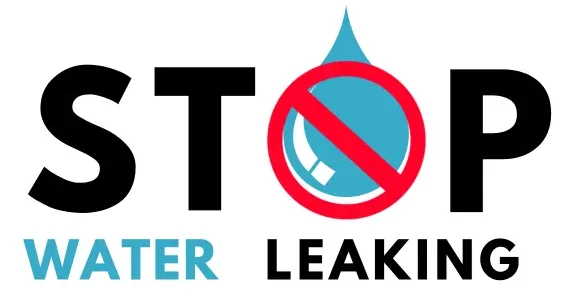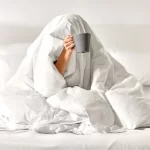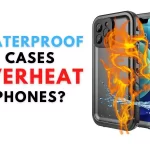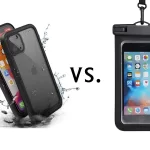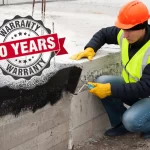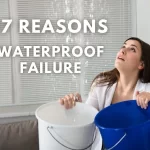When you are selecting the waterproof or water-repellent fabric, you need to know the difference. There is a huge difference between water-repellent fabrics Vs. waterproof fabrics. When you study carefully, you can observe the difference. So check it.
Waterproof fabrics are not allowed to pass water through the fabric, and the pores are covered with polymer or membrane. Water repellent fabrics have air permeability, but it is less water protection, Mostly used in the exterior layer of waterproof fabrics.
That means water repellent fabrics are the materials for waterproof fabrics. If you carefully read this, you can find it. So let’s keep reading on!
Water Repellent Fabric
The water repellent of the fabrics depends on the contact angle of the water drop when it is on the fabric.
Contact Angle of a Water Drop
When a water drop is on the surface, it can touch the contact surface by creating an angle due to the surface tension.
The angle where it is created with the surface and the outer surface of the drop is the contact angle for that surface.

According to the contact angle, materials can be classified as below.’
- Superhydrophilic materials θ = 0 angles;
- Hydrophilic materials (including textiles) 0 angle<θ<90 angles;
- Hydrophobic materials (including textiles) 90 angle θ<150 angles;
- Superhydrophobic materials (including textiles) 150 angle θ<180 angle
You can observe when the contact angle is high; it is more water-repellent material. We called it is Hydrophobic material. Check more about contact angle.
According to the contact angle behavior, the water repellent effect is obtained. There are two groups of textile materials.
Inherent Water Repellent Textile Materials
Inherent water repellent materials can be categorized into two.
(i) High-Density Woven Fabrics
These high-density woven fabrics are made with special surface properties. To maintain the water repellent characteristic, the fibers are made of synthetic polymers such as PTE, PA, PP, and PAN.
(ii) Nonwoven Materials
The non-woven materials are carried out with different chemicals that ensure high superficial tension in relation to water.
Textile materials with water repellent finishing
Using the repellent material, the textiles can be finished as water-repellent fabrics.
Waterproof Fabrics

Generally, conventional waterproofing treatments lead to the impossibility of fluids passing through textile materials due to the closing of the pores by covering them with a layer of polymer or a membrane. According to the morphological structure and technology, waterproof materials can be classified as follow.
This is my favourite list of 09 Best Waterproof and Breathable Fabrics. You can try it.
01. Inherent Waterproof Materials
This is with compact, nonporous structures that are completely impermeable to liquid or vapor water, namely.
➤ Polymeric foils
Low-density polyethylene (LDPE) and polyvinyl chloride (PVC) are the thermoplastic polymers most used for foils and films, the production technology requiring the planar extrusion of the melted polymers.
Textile materials laminated with polymeric foils.
Polymeric foils are suited for waterproof clothing due to their isotropic and compact structure, the
low thickness (0.25–0.5 mm), and specific mass, the pieces being joined using adequate welding techniques.
02. Textile materials with waterproofing finishing treatments (coated and laminated).
By using surface covering treatments, coated and laminated waterproof fabrics can be produced.
➤ Coated Waterproof Fabrics
Coated waterproof fabrics are made by depositing polymers uniformly on the entire textile surface as a solution or a low or high viscosity dispersion using different processes. And here, you cant observe the solution layer and fabric separately. Both will see combined fabric as well.
Most used coatings
- Synthetic rubbers
- Polyolefins
- Polyvinyl chloride
- Acrylic derivatives
- Polyurethanes
➤ Laminated Waterproof Fabric
The components used for the laminating process can be clearly visible at the microscopic level. Both sides or a single side can be laminated as it needs. Two or more layers can be bonded together according to the properties to be added to the fabric.
According to the use of layers, fabrics can be named 2L (layer), 2.5L, and 3L. There is an inner material such as linen or cotton and out material is specified material. Because of this, the fabrics are more costly compared to the water repellent fabric.
The cost of waterproof fabric is always more than a normal cloth. So you had better choose the right waterproof cloth every time.
According to the point of view above detail, it is clear that water repellent fabrics are used for waterproof fabrics. Water repellent is a single-layer fabric, and it is only water-resistant and with high breathability.
It is not suitable for outer usage. Because of this, water repellent fabrics are used for waterproof fabrics with additional layers and coatings in order to increase waterproofness and breathability, and more comfort.
Related Questions
Is Water Resistant Fabric Waterproof?
Water-resistant fabrics are always not waterproof. Water-resistant fabrics are made with synthetic polymers such as PTE, PA, PP, and PAN by tightening woven. So the inside pours are high, and a certain extent of water can be passed through this fabric. Therefore it is not waterproof.
Which is Better Waterproof or Water Repellent?
Water repellent fabrics are tightly woven with synthetic polymers such as PTE, PA, PP, and PAN, and waterproof fabrics are made with more layers. The pores help to transfer the water through the fabric. More pores are in the water repellent fabrics, and fewer pores are in the waterproof fabric. So waterproof fabric is better than water repellent fabric.
What type of Fabric Repels Water?
The fabric, which is made with synthetic polymers such as PTE, PA, PP, and PAN, is highly water repels. The fineness of these fabrics is 0.3–1 dtex, with the interval 0.3–0.1 dtex for super-microfibres. These fibers, which are used for the fabrics, act as water repels.
Related Topics
- Why I Bought 15000 mm Waterproof Jacket?
- 07 Best Eco-Friendly Waterproof Fabrics: Love Green
- 21 Best Waterproof and Water Resistant Fabrics – Top Brands
